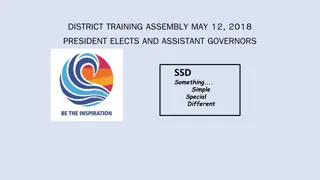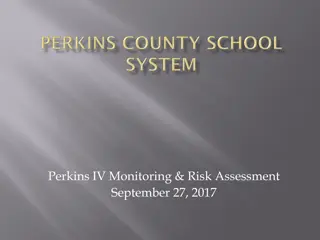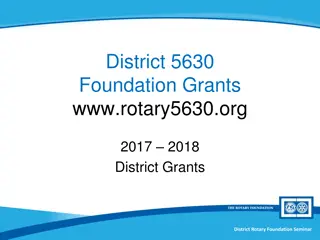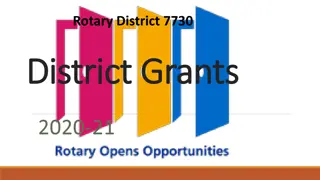Considerations for Establishing a School District Foundation
Establishing a school district foundation can provide various benefits such as streamlined receipt of gifts, enhanced fundraising opportunities, and support for diverse educational initiatives like scholarships, supplies, and technology upgrades. Board foundations offer a cost-effective way to manage funds, ensure tax-deductible donations, and align investments with school fund guidelines. By creating a foundation managed by the Board, schools can facilitate community contributions and transform educational experiences for students.
Download Presentation

Please find below an Image/Link to download the presentation.
The content on the website is provided AS IS for your information and personal use only. It may not be sold, licensed, or shared on other websites without obtaining consent from the author. Download presentation by click this link. If you encounter any issues during the download, it is possible that the publisher has removed the file from their server.
E N D
Presentation Transcript
Educational Foundation Considerations Prepared for Groveport Madison School Board
1. Why a Foundation? 2. Board Foundations 3. Independent Foundations 4. Preliminary Conclusions + Next Steps TODAY We ll Discuss
Why a FOUNDATION?
(RC 3313.36(B)) - Streamlined receipt of all gifts through omnibus Board resolution to accept any gifts into the foundation that either: Are given specifically to the foundation, or Are given without conditions or limitations. Why a Foundation? Provides comfort for donors to be more willing to donate without conditions or restrictions on their funds Helps fundraising messaging
Typical use of a school district foundation would be for: College Scholarships Back-to-School Supplies Model UN team expenses Library reading program STEM bins Sensory installations in school hallways Expanded library selection Biotechnology teacher training String instruments Yearbook photography equipment Salad bars for healthier lunch options Author visits Lego Stations Smartboard for specific classroom Why a Foundation?
Board FOUNDATIONS
A foundation can be created and managed by the Board Created by simple Board resolution Board Foundations The foundation is not a separate legal entity from the Board itself It is maintained by the Treasurer, under the same accounting standards as all other school funds A committee may be appointed to administer the funds
Board Foundations - Benefits Streamlined acceptance of gifts (vs. separate board resolution for each gift) Donations are tax-deductible for the donor as a contribution to a political subdivision under Section 170(c)(1) of the Internal Revenue Code Less expensive than the legal and accounting work to maintain a separate 501(c)(3) No need to locate dedicated independent trustees Funds may be invested along the same guidelines as other school funds Written funding policies or initiatives may be developed, but would not be required
Board Foundations - Restrictions A Board may not create or use a foundation if it has an outstanding emergency school assistance loan or if it has received funds from the Ohio Facilities Construction Commission and not repaid its local share Each expenditure from the foundation must be approved by the Board in a separate resolution (even if recommended by committee) Expenditures must be made for operating or capital costs of any existing or new and innovative program designed to enhance or promote education within the district or ESC, such as scholarships for students or teachers RC 3315.40 These uses of funds are more restrictive than if the foundation was independently managed as a separate entity with a separate Board of Trustees.
Independent FOUNDATIONS
An independent foundation may be set up to benefit the school district, but it is created and managed separately from the Board Independent Foundations This type of foundation would be a separate 501(c)(3) entity At least 3 independent directors are needed to run the foundation, not current board members or employees of the district
Independent Foundation - Requirements Set-up as a nonprofit Ohio corporation with Articles of Incorporation, Code of Regulations, Conflict of Interest Policy, EIN, bank account File Form 1023 with the IRS to seek tax-exempt status as a 501(c)(3) Register with the Ohio Attorney General as a charitable trust Annual reporting to the IRS and Ohio Attorney General Funds would be maintained separately from school district (i.e., not by the Treasurer) All other compliance with general 501(c)(3) rules (no inurement to anyone s private benefit; restrictions on lobbying activities, etc.)
Independent Foundation Other Notes Donations are tax-deductible as contributions to a 501(c)(3) (assuming IRS grants tax-exempt status) Funds must be used in accordance with the governing documents and for an exempt purpose Exempt purposes = charitable, religious, educational, scientific, literary, testing for public safety, fostering national or international amateur sports competition, and preventing cruelty to children or animals These uses of funds are more expansive than a Board-managed foundation A representative from the Board or school district could be a non-voting participant on the foundation board to ensure continuity between district/board and foundation operations
Donations to either type of foundation would be tax-deductible for individual or entity donors, to the full extent of the law Each taxpayer, whether individual or entity, is subject to limitations that may affect their ability to take a deduction in any particular year Any written materials to donors should specify that donors should consult their tax advisor regarding questions about their ability to take deductions If donors receive anything of value in exchange for their contribution, the value received is deducted from the amount of tax-deductible donations they have made Tax-Deductible Contributions
Example: Donor pays $200 for a fundraising dinner, but the dinner cost $50. Deduction = $150
Entities receiving tax-deductible donations must provide a receipt/letter for all amounts received, including: whether the donation is tax-deductible under 170(c)(1) or 501(c)(3) Tax-Deductible Contributions whether or not the donor received anything of value in exchange for contribution the value of any goods or services received by the donor
Preliminary CONCLUSIONS
Preliminary discussions indicate that Groveport Madison is interested in initially keeping the foundation as a Board-managed foundation This will save initial costs and keep control with the Board, as well as eliminate the need for independent directors in the short term At any time, an independent foundation can be established, however, once funds are held in a Board foundation, they cannot be transferred over to an independent foundation. Consider whether the slightly more expansive use of funds restrictions for independent foundations changes this analysis
NEXT STEPS Assuming Board Managed Model
Resolution to create foundation Resolution to create commission to administer foundation Resolution to allow Treasurer to accept all gifts/donations/grants into the foundation that either 1) are expressly given to foundation (without conditions/limitations) or 2) are given to the district without conditions or limitations Board Resolutions Reminder: all expenditures from foundation still need specific Board approval
Consider whether district/committee wants to establish written grant policies Consider development of written fundraising/marketing materials for donors describing the foundation and its goals/initiatives Decisions
Erin Herbst eherbst@keglerbrown.com keglerbrown.com/herbst 614-462-5420 Adam Miller amiller@keglerbrown.com keglerbrown.com/miller 614-462-5453























